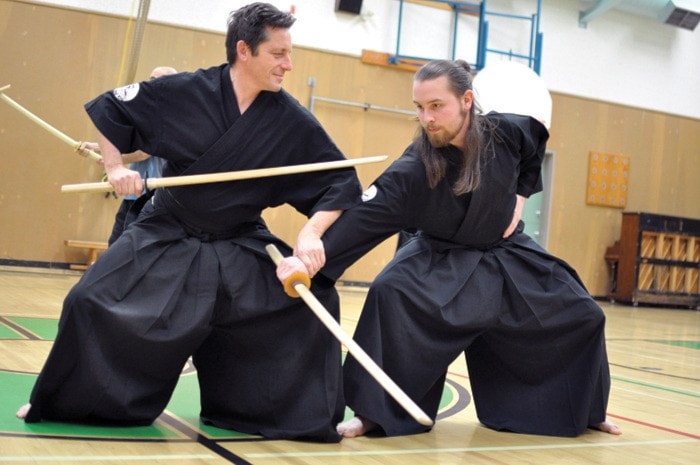If tango is the passion of dance, then Iaido is surely the zen of swordplay.
Iaido (pronounced ee-eye-doe) is the art of drawing and cutting with a Japanese sword, and Ladysmith is currently home to a sixth degree black belt (rokudan) instructor. Every week, enthusiasts gather in the gym at Ladysmith Primary School to learn and practise this ancient art form.
“Iaido is training of the body, spirit and mind all in one, where the body combined with the mind works on the targeting and the efficiency of all that you do based on sword work of hundreds of years ago,” says sensei Peter Gunstone of Todo Kai, the local dojo.
The purpose of Iaido, he said, is to develop awareness, centered-ness, sincerity, a calm mind, and mental and physical harmony through the practice of the sword techniques, also referred to as waza.
“The school that we practise is called Muso Jikiden Eishin Ryu,” Gunstone said. “We have a teacher/student relationship that hasn’t been broken; it’s been passed on and it’s an oral tradition.”
Iaido is an old martial art developed by the samurai warriors as an exercise to keep their skills sharp. Beginner students learn with a bokken, a Japanese wooden sword, until they are skilled enough to start working with the real thing.
“They teach muscle memory rather than thinking about using your sword,” Gunstone said. “Although it’s not aerobic, there’s a lot of kneeling and upper body exercises that are in it.”
He added that Iaido is all about striking with precision, leading to many hours of perfecting each movement. Actual use of the sword is a last-resort measure.
“If you were going to have to hurt someone back in the days of yore, you wanted it to be quick, accurate and merciful,” he said. “The victory is in the scabbard, so if the sword stays in the scabbard, that’s the best place for it.”
Ian Perry, who has studied Iaido for nine years, said he enjoys the energy he gets after each session.
“It’s about focus and self-discipline and it’s an interesting group. We’re very unique individuals,” he said.
As a senior student, Perry will often help out with the less experienced students. He said Iaido is more about competing with yourself than an actual opponent.
“You are developing your skill, and you get out what you put into it,” he said.
Stephen Mercer, 19, said being involved in Iaido helped him a great deal when his father passed earlier this year.
“It helps me focus and it helps me control my emotions,” he said. “I pack [them] at the door when I’m here and I leave my problems.”
When he’s not taking his bi-weekly classes in Nanaimo and Ladysmith, Mercer practises Iaido at home.
David Borys has studied Iaido for the past three and a half years.
“It’s passing on a way of life [and] a tradition that I admire greatly,” he said. “It’s unique and it’s beautiful.”
Gunstone has studied Iaido for over 30 years and has also practised Kendo, a more physical version of Iaido.
“My grandfather spent a lot of time in [the]Orient so I was always fascinated with Japan,” he said.
He said an added spin-off to Iaido is the cultural aspect.
Iaido is taught in Ladysmith Monday nights at 7:30 p.m. at Ladysmith Primary School. Classes resume Jan. 9, 2012. For more information, or to sit in on a session, contact Gunstone at 250-924-8114 or e-mail gunshot@shaw.ca. Todo Kai’s website is www.todokai.ca.
